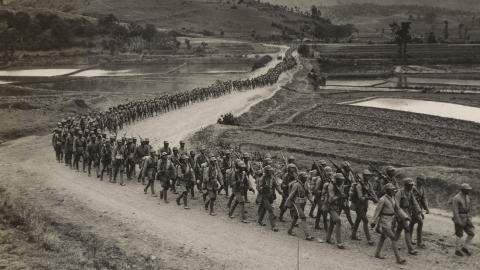
The Tuskegee airmen: America's first black aviators
Photograph of Tuskegee airmen attending a briefing in Ramitelli, Italy, March 1945 | Library of Congress | Public Domain
Formed in 1941, the Tuskegee Airmen were the first black aviators of the American military. Having been refused access to service throughout WWI, black Americans advocated for the right to serve their country. In the years following WWI, the technological advancements of air travel, along with the publicity around aviators like Charles Lindbergh and Amelia Earheart, the popularity of aviation had boomed. With the onset of WWII, with the U.S. Military still practising segregation, the Tuskegee Airmen were formed at the Tuskegee Airfield, Alabama.
Racial tensions at the time were high. Despite the boom in the popularity of aviation throughout the 20s and 30s (thanks to pioneers like Lindberg and Earheart), due to racist policiies before the Tuskegee Airmen, black pilots were not allowed to train to become airforce pilots. However, the growing personnel constraints of the ongoing war and advocacy from civil rights groups led the White House to announce that they would begin training black pilots. Here are five facts about the Tuskegee Airmen that you might not have known.
Not everyone was on board
Pilots born in the north hadn’t experienced the entrenched racism that was still prevalent across the southern states. Upon receiving their billing orders, many were shocked to see the difference in treatment they received upon arriving in Alabama. Many were presented with hurdles and roadblocks that limited their military career progression from those higher up in the chain of command. Others noted that while they were training, they were afforded fewer rights on base than the German prisoners of war being held there due to Jim Crow laws.
It wasn’t just pilots
The Tuskegee Airmen didn’t consist solely of fighter pilots and bombardiers. There were only 992 pilots, but with ground staff, cooks, nurses, mechanics, and other additional support personnel, the Tuskegee Airmen totalled 14,000 individuals. The unit continued until the abolition of segregation in the US military in 1948; however, many Tuskegee Airmen went on to fly in the Korean and Vietnam wars.
Red Tails
The Tuskegee airmen were best identified in the air by their distinctive liveries. Most often flying Mustang P-51s while escorting American Bombers, the distinctive liveries with bright red tails, red nose cone with yellow banding, and red wing tips coined the nickname 'the red tails'.
Escort Duty
It was commonly rumoured that the Tuskegee had never lost a bomber they had been escorting. However, this wasn’t entirely true. Records show that around 27 bombers were lost to enemy combatants during their aerial campaigns. However, compared to the average of the six other escort groups of The Fifteenth air force sitting at an average of 46, the Red Tails had considerably fewer losses.
Hero’s Welcome
When returning from fighting both in Africa and Italy, the Tuskegee Airmen didn’t receive the hero’s welcome that many would have expected. Hoping that their sacrifice would afford them the same reception as white soldiers returning from duty, they were dismayed to find that as they disembarked from the boats that they sent in a different direction to their white counterparts.
They received no recognition outside of their families and close communities. The first publication that told the stories of the airmen wasn’t published until the mid-1950s.
Want to know more? Tuskegee Airmen is a one-hour special in which US broadcaster Robin Roberts explores the legacy of a legendary group of African American pilots, including her father, who served in WWII, revealing how these warriors for change helped end segregation the military and paved the way for the civil rights movement.
For more articles about Black History, check out Sky HISTORY's Black History Month hub.



















